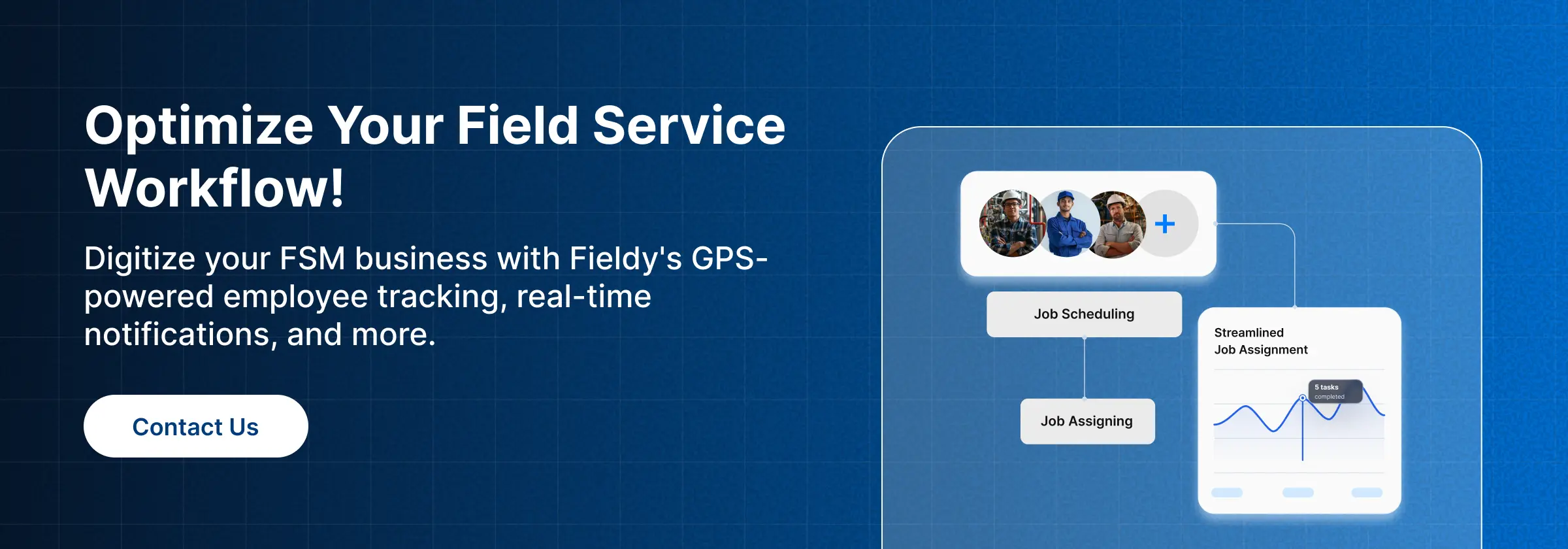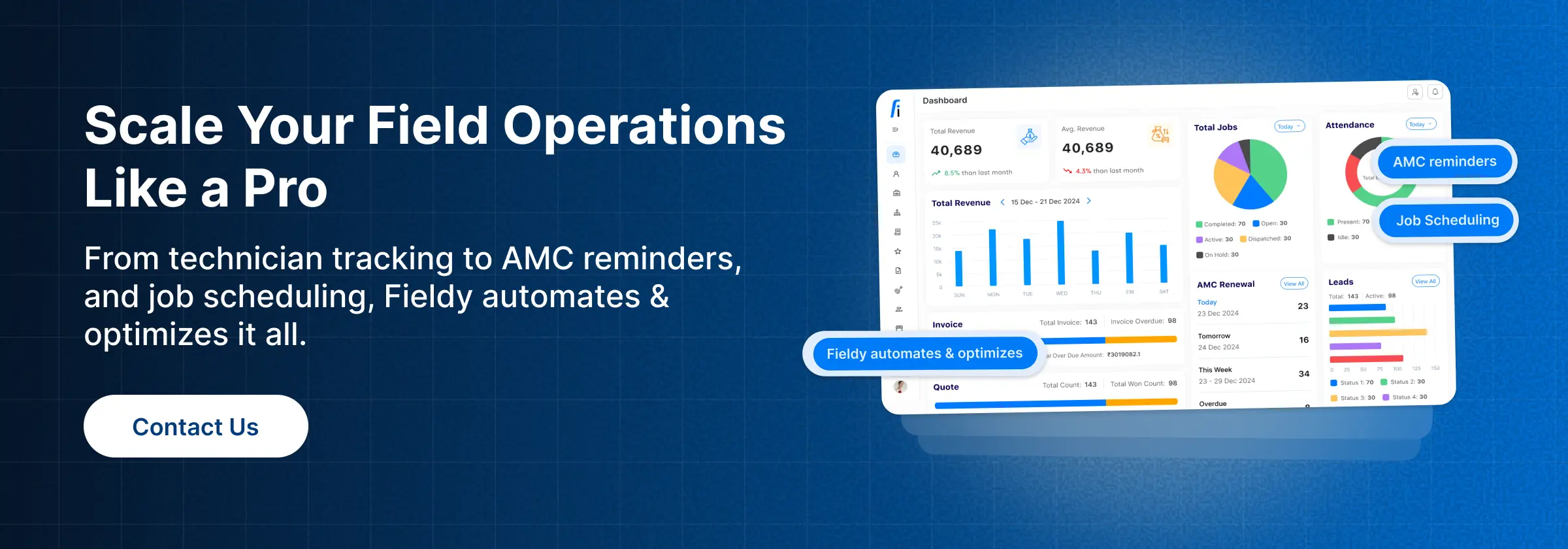🏗️ Introduction
Definition & Why EAM Matters in Field Service:
In the ever-evolving world of field services, assets are paramount in ensuring dependable service. What would one call an asset management system or enterprise asset management software? In simplest terms, it is a central platform meant to manage every aspect of an asset’s existence within an organization-from purchase, operation, maintenance, and finally through to decommission.
Field service management companies operating in HVAC, elevator maintenance, security systems, or pest control have their own sets of challenges: unforeseen downtime, engineering complexities in maintenance schedules, and pressure of regulatory compliance. Asset management companies help reduce unplanned downtime, give optimal schedules to technicians, and ensure safety compliance. Enterprise asset management has evolved with platforms such as Fieldy; thus providing scalable solutions for smaller teams and enterprises alike and showing how the asset service management and asset management solutions simplify preventive maintenance, contracts, and compliance tracking.
⚙️ How EAM Differs from Basic Asset Management
While simple asset tracking may only record locations, usage, or a basic service history, enterprise asset management software (EAM) provides a complete, holistic view of asset performance and lifecycle. Key differences include:
- Comprehensive Functionality 🧩:
EAM goes beyond tracking by integrating asset planning, preventive and predictive maintenance, cost management, compliance tracking, and reporting.
- Proactive Maintenance 🔧:
Traditional asset tracking in HVAC, for example, only logs the last service date. EAM platforms schedule preventive and predictive maintenance, monitor equipment condition, and track AMC renewals, helping businesses reduce emergency callouts and extend equipment life.
- Real-Time Alerts and Monitoring 🚨:
Companies can set up alerts for potential failures. For instance, a commercial HVAC company identified compressors showing early signs of wear and serviced them before total failure, avoiding costly downtime and enhancing customer satisfaction.
- Structured Asset Lifecycle Management 🔄:
EAM ensures a lifecycle structure from procurement – utilization – servicing – decommissioning, which improves operational efficiency and reduces repair costs.
- Industry Adoption and Market Growth 📈:
The global EAM software market is growing rapidly, estimated at USD 7.65 billion in 2024 and projected to reach USD 8.89 billion in 2025, with expectations to hit USD 19.68 billion by 2030. This demonstrates widespread adoption across industries seeking streamlined maintenance, better compliance, and operational efficiency.
- Operational Benefits 💼:
Organizations implementing EAM report improved first-time fix rates, reduced repair costs, and extended asset lifespans. This is particularly critical in industries like HVAC, elevators, and security systems, where downtime directly impacts revenue and customer trust.
By shifting from reactive to proactive service strategies, EAM enables businesses to maintain compliance, enhance customer trust, and achieve measurable operational benefits.
🧠 Core Features of Enterprise Asset Management Software in FSM
A robust EAM platform incorporates features designed to streamline field operations and integrate seamlessly with other tools. A centralized asset register and database provides full visibility across all locations, while preventive and predictive maintenance scheduling helps avoid costly failures, supported by analytics that reduce downtime.
For field teams, contract and warranty management automates AMC renewals and ensures compliance, reducing administrative burden. Asset condition monitoring detects wear and tear early, allowing technicians to address issues proactively.
With mobile access, technicians can update service records in real time and access asset histories instantly, improving efficiency. Integration with scheduling, invoicing, and CRM systems ensures that service data aligns with business operations, illustrating why job scheduling software in FSM and EAM together creates smoother workflows. ⬇️⬇️⬇️
💡 Benefits of Enterprise Asset Management for Field Service Teams
Implementing enterprise asset management software delivers tangible benefits. An extended asset lifespan is achieved through consistent servicing, while predictive maintenance reduces the cost of emergency repairs. Optimized workforce allocation ensures technicians are dispatched based on skill, location, and asset requirements, connecting operational efficiency to customer satisfaction.
Real-time data and transparency allow managers to track assets and service completion accurately, and customers gain confidence knowing their equipment is maintained systematically. Many field service businesses also integrate EAM with employee productivity software, ensuring teams remain accountable while maintaining high-quality service.
Case Study 🌐: A UK-based elevator service company improved its first-time fix rate by 22% after adopting these practices, showing measurable operational benefits.
🚀 How Fieldy Powers Enterprise Asset Management
Fieldy exemplifies modern enterprise asset management software by combining usability with advanced capabilities. Its scalable platform supports both SMBs and enterprises, while smart AMC and contract management automate renewals and alerts, ensuring no contracts are missed. No-code custom checklists help standardize processes, and live technician tracking and communication tools keep field teams aligned.
Fieldy also provides real-time inventory updates, so technicians always have access to critical parts, reducing delays. Electrical service companies using Fieldy have reported significant reductions in overtime while improving repeat customer engagement, highlighting the real-world impact of integrated EAM solutions. Integration with lead management software further enhances operational efficiency by connecting asset servicing with customer relationship tracking.
🏭 Industries Benefiting from Enterprise Asset Management
Several industries see clear advantages in adopting EAM solutions, as they streamline asset usage, reduce operational costs, and enhance compliance.
- HVAC Companies 🌬️– These businesses manage seasonal demand, monitor system loads, and schedule preventive servicing with greater accuracy. By leveraging EAM platforms, often integrated with the best HVAC software for small businesses, they can cut emergency breakdowns, ensure customer comfort, and maximize technician productivity.
- Elevator Companies 🛗– Safety and compliance are top priorities in this sector. EAM enables timely inspections, predictive maintenance, and detailed reporting, which aligns with the best elevator management software in field service management (FSM). This ensures fewer unexpected breakdowns, higher uptime, and stronger regulatory compliance.
- Security System Providers 🛡️– From cameras to access control units, hardware reliability is critical. With EAM’s integrated asset tracking and maintenance scheduling, similar to the best security system software, companies can reduce downtime, extend equipment life, and deliver uninterrupted service to clients.
- Pest Control Companies 🐜– EAM helps track specialized equipment, chemical usage, and service schedules. By integrating features of the best pest control software, businesses ensure technicians always have the right tools and resources on time, improving operational efficiency and compliance with safety regulations.
Insights 🧠: Industry case studies consistently show that businesses adopting EAM can reduce downtime by up to 30% while improving service quality and workforce efficiency. For field-heavy operations, this makes EAM not just beneficial but indispensable for long-term competitiveness.
🔮 Conclusion:
Future of Enterprise Asset Management in FSM
The future of field service revolves around IoT-enabled monitoring, AI-powered predictive maintenance, and cloud-based, mobile-first solutions. Understanding what enterprise asset management software is and implementing platforms like Fieldy allows businesses to optimize assets, streamline workflows, and maintain high service standards.
By combining asset lifecycle management, predictive maintenance, and workforce optimization, companies can reduce operational costs while enhancing customer trust. These strategies also align naturally with broader field service optimization and route optimization approaches, enabling comprehensive operational efficiency across teams and locations. ⬇️⬇️⬇️
FAQs❓
What is enterprise asset management software?
Enterprise asset management (EAM) software is a centralized system that manages all assets across their lifecycle. It tracks maintenance, compliance, costs, and service history, helping field service teams stay organized and efficient.
How is EAM different from basic asset management?
Unlike basic asset tracking, EAM includes preventive and predictive maintenance, lifecycle planning, compliance monitoring, and reporting. It provides actionable insights to reduce downtime and optimize resource utilization.
Which features are essential in EAM software for field service?
Centralized asset database, predictive maintenance, AMC tracking, condition monitoring, mobile access, and CRM integration are essential features, ensuring efficient operations, reduced downtime, and enhanced customer satisfaction in field service.
How does EAM improve technician productivity?
EAM gives technicians real-time asset visibility and mobile access to updates, service histories, and automated maintenance alerts, reducing travel and ensuring faster, more accurate job completion.
Which industries benefit most from EAM in field service?
Industries like HVAC, elevator maintenance, security systems, and pest control benefit from EAM through improved uptime, efficient workforce allocation, regulatory compliance, and enhanced customer satisfaction.




